Broiler turkeys - a type of poultry, its breeding is practiced by many farmers and agricultural enterprises. They are famous for their unpretentiousness, calm disposition, fecundity and excellent taste indicators of dietary meat.
In this article, we will look at how to raise broiler turkeys at home, how to feed broiler turkeys and how to avoid common diseases.
Table of contents
general description
The body of broilers is massive, muscular, impressive strong beak with a red appendage. Birds run fast, developed wings allow to fly over three-meter fences. They reach speeds of up to 50 km / h.
Farmers consider turkey broiler breeds to be selective eaters requiring specific housing conditions.
There are a number of nuances, recommendations that have a productive impact on the development of poults, maintaining the health of the whole brood. Spent forces pay off in a short time, due to the high growth rate of broilers.
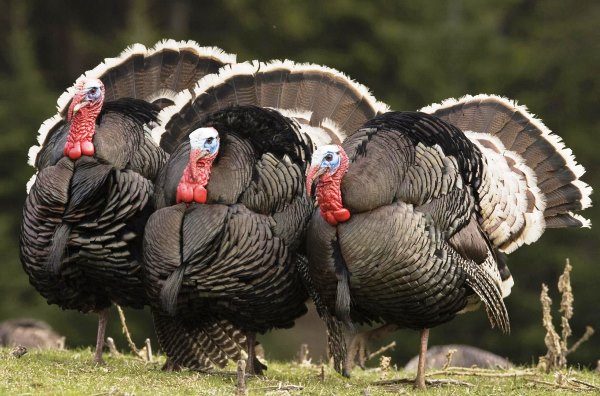
Conditions of broiler turkeys
Small broiler turkey poults should be kept in a specially equipped house.
Primary requirements:
- comfortable temperature;
- dry cell;
- unlimited free access to water;
- the presence of ventilated air.
The warm season is a great time to start growing broiler poults at home,providing the opportunity of walking the young in the compound. The cages are wide: turkeys require large spaces.
Grown up grown up individuals let out on a poultry yard to eat kilograms. Broiler turkeys are home-bred birds. Some breeds are actively grown by large agricultural enterprises.
External characteristics and distinctive qualities
Broiler turkeys are gigantic in size. The weight of adult males is 20–30 kg. Females grow much smaller in size: twice as lighter than males.
The main purpose of growing broiler turkeys is to produce high quality meat. Egg production is an important indicator, however, not the main one. The onset of egg laying, the mass, the number of eggs produced depends exclusively on the breed of broiler turkeys.
Now let's talk about how to feed broiler turkeys at home. Adults recommended to feed 4 times a day. Broilers always need open access to the feeder, otherwise there will be a shortage of mass. Preferably compliance with the diet. Inconsistent choice of hours of feeding leads to malnutrition.Attacks of hunger are accompanied by irritability, aggressive behavior of birds.
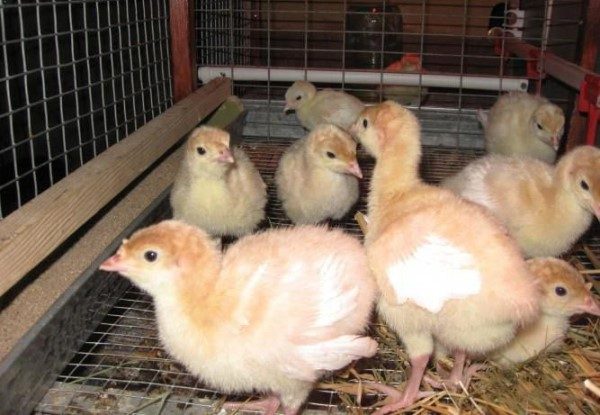
Species breeds
The key to successful breeding of healthy fed-up turkeys is an individual approach to the choice of methods for keeping a certain breed. There are three main types of broiler turkeys.
- Light breeds. Do not exceed 15 kg. Males weigh less than females - about 10 kg one carcass. Disease-resistant strong individuals, females have high rates of egg production. These include Norfolk, bestvilskuyu, white Dutch breed.
- Medium-sized broilers. Highly productive individuals weighing 16 kg. This includes Moscow and North Caucasian turkeys.
- The largest breed. The most popular type of broilers. The weight of adult males reaches 30 kg. Females grow twice less - 12 kg. The classification refers here to the broad-chested Canadian whites, Canadian bronzes, big 6.
You will also be interested to know about:
- How to grow Big 6 turkeys at home
- How to breed turkeys at home
Many farmers are free to choose among the crossed breeds of local turkeys. They are more hardy. Hybrid broilers rarely exceed a weight threshold of 10 kg.
The most highly productive and sought-after household farms are heavy breeds:
- Canadian broiler wide-breasted. The breed is bred by careful selection. Eat almost all types of feed. The diet should contain various prikormki, vitamin complexes. Weight gain is fast. A month and a half later, the chicks reach 5 kg. After another one and a half, they are ready for slaughter for meat. The egg-laying of females begins at nine months, the number of eggs laid per year reaches 200 pieces.
Canadian wide-breasted broiler turkeys are considered the largest among other members of the early breeds. The weight of an adult male in three months can reach 30 kg.
- White wide-breasted. Males reach 25 kg in weight, females - 11 kg. Have an average growth rate. At five months of age, the weight of the chick is 7 kg. Breed representatives are fastidious about food. Females have a high degree of egg production - 100 eggs per year, 90% of them will produce new chicks.
- Big 6 - A relatively young breed of domestic heavy cross, was bred in 2007 in the UK. It has impressive ratios of total body weight tothe amount of pure meat. External signs resemble a white wide-breasted, the level of productivity is similar to the Canadian. In 3 months reaches slaughter age. Weight can reach 30 kg.
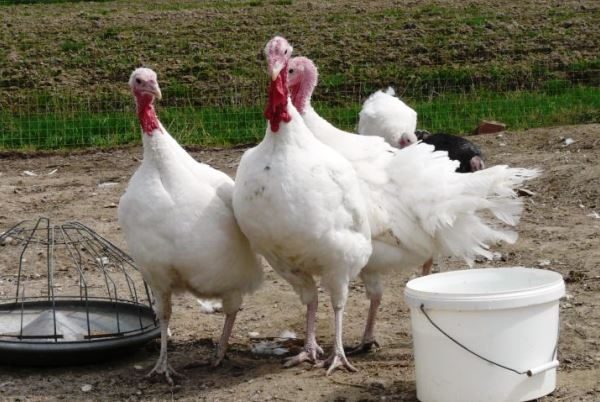
How to feed turkeys and broiler turkeys at home
Feeding broiler turkey poults at home must necessarily be a special feed, for example, zero. It contains all the necessary nutrients. After 14 days begins a smooth transition to a mixture for the young chicks.
Two weeks later, crushed oats and wheat are gradually added to the usual feed. Improve the work of the intestine will allow river sand, crushed shells, chalk. Sometimes you can pamper chicks with a hodgepodge of sour milk, boiled potatoes and bran. It is necessary to chop everything thoroughly before serving the turkeys - large pieces of food can clog the airways and the bird will die.
From the age of three months, the diet of broiler turkeys should consist of the following types of grain:
- wheat (50%);
- barley (20%);
- corn (10%);
- oats (10%);
- compound feed (10%).
Adults along with small broilers need to eat a lot of different greens - onions, nettles, carrot tops, beetroot, cabbage leaves. Any vegetable will do.
Features breeding and cultivation
Newly hatched turkeys are kept in a pre-heated room. It is important to observe the temperature regime for the first 2 weeks (22–25 degrees Celsius). The health of chicks depends on maintaining a comfortable environment. Feeders should be established, excluding the occurrence of accuracy among the chicks, otherwise the weak individuals will be malnourished or they will simply be trampled.
Clean water is an important part of proper broiler brood care.. Suitable vacuum and nipple drinkers.
The house should be ventilated.On the street content of turkeys transferred after 2 weeks. Now you know about the breeding and maintenance of broiler turkeys at home.
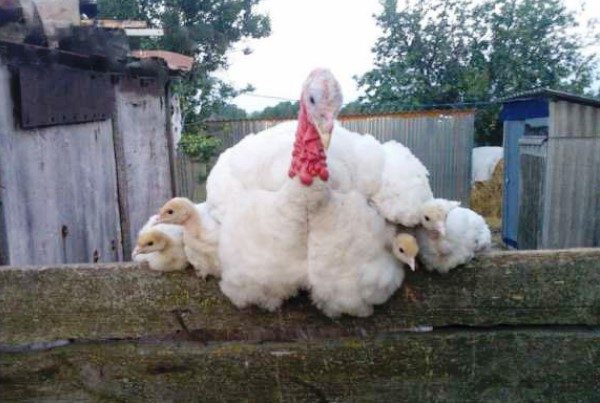
Prevention of diseases of turkey poults
Broiler turkeys - birds susceptible to diseases of the gastrointestinal tract. Preventive measures:
- compulsory vaccination;
- antibiotics.
Pros and cons of growing
Growing turkeys has positive and negative sides. Should consider them in more detail.
Pros:
- homemade turkey meat ecologically clean, contains a huge amount of beneficial vitamins and trace elements, is famous for its low fat content, is dietary;
- eggs of broiler turkeys have high nutritional value and high taste;
- breeding for the purpose of selling pays off quickly. Meat is considered more rare, costs more;
- seasoned breeders know: breeding and further sale of turkey products is practically waste-free. You can sell feathers, down, eggs, meat, chicks of any age.
Minuses:
- special conditions of young stock, high risk of mortality;
- juveniles require keeping far from other poultry due to possible diseases; chicks are shy;
- prone to obesity, for the prevention should be given more greens.
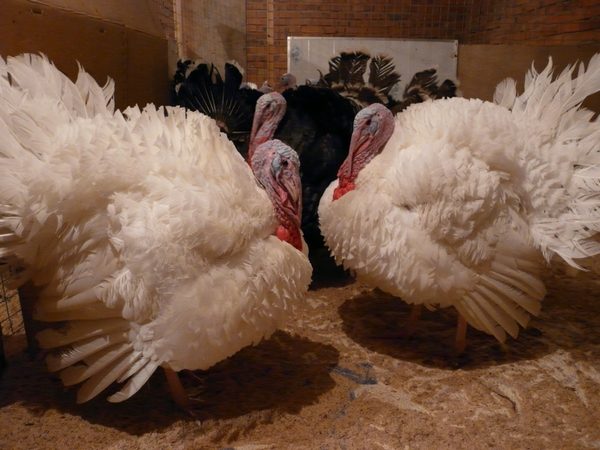
Farmers Reviews
The Internet is replete with forums dedicated to broiler turkey breeding. Statistics show: business is very profitable, the cost of food pays off by selling two out of ten turkeys.
Our family has been raising turkeys for over two years. For the first time they took ten turkey poults to try, whether the case would go - not one was sick. For two months they were fed special Provimi turkey feed, later PK-4 broiler feed. Having decided to start breeding, a number of doubts immediately arose. But we managed, not how much I regretted! A year later, 35 chicks were taken immediately, only one died a day later. The bottom line: the broilers have grown huge!
You have to take it easy, it's worth all the effort. The main advantage of broilers is a lot of meat! After the turkeys, the chickens seemed like pigeons. I really liked them to breed. One bird weighed 15–17 kg. Enough to feed the family, and it is possible to sell immediately.
Some farmers have experimented with alternating feeds intended for other types of poultry, such as chicken mixtures. Monthly broilers grew healthy, reaching 25 kg of weight.
Economic managers practicing broiler breeding are convinced: recommendatory methods of maintenance do not require strict observance, the bird is hardy and unpretentious. A brood of large healthy birds really get, putting some effort. Years of experience with the peculiarities, nuances of broiler turkeys content convinced the breeders - the work is really worth the effort.
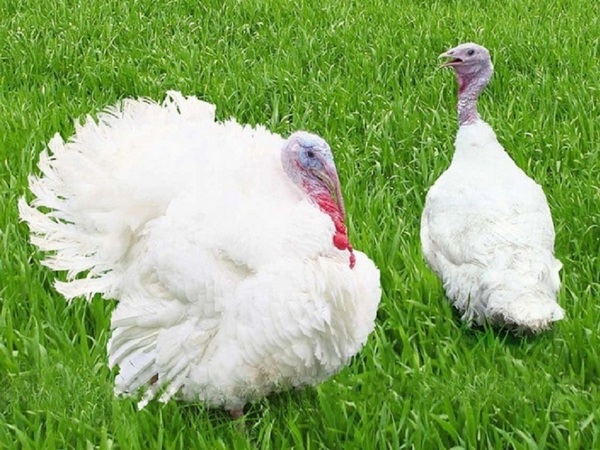
Help me cure, please! The other day, one of our turkeys seemed to have gotten cold, the beak swelled up so that even the eyes swelled, and mucus was constantly bubbling out of the nostrils.
Please contact your local veterinarian. I can not treat through the Internet.
It is necessary to lubricate all the volts on the induction with iodine. Drink by adding a few drops of iodine alternating with manganese. From personal experience, I grow a bird of 17 years. Good luck for the future !!
the author even tried to grow turkeys
ridiculous. download info from site to site only pictures change
do not write any nonsense and do not mislead people
Well, can not a turkey in 3 months to grow about 30 kg
for 6 months, about 20 kg is more likely and then .......